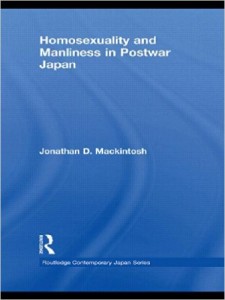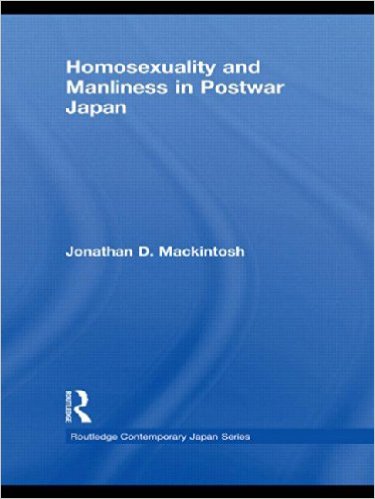 Homosexuality and Manliness in Postwar Japan
Homosexuality and Manliness in Postwar Japan
by Jonathan D. Mackintosh
Routledge. 261 pages, $125.
IMAGINE a magazine arriving in the mail every month, over 300 pages filled with news, photos, and information that you never talked about with anyone. In the days before the Internet, that’s how gay life was organized in Japan.
The breakthrough came in 1971 when a writer and publisher, Itō Bungaku, launched a magazine for gay people in Japan. The magazine was called Barazoku, the “Rose Tribe,” perhaps because (to use the Buddhist metaphor) the rose is beautiful to look at and grows in many places, but it springs from a stem of thorns (i.e., straight society). Barazoku was the leader in the field and held its own even when a number of similar magazines began to circulate. It was published from 1971 to 2008, and at its height boasted 30,000 copies sold each month, with a readership easily two to three times that number.
Itō was straight, as he kept proclaiming, but he felt gays could build meaningful and fulfilling lives by learning how to value themselves and by experiencing solidarity with fellow gays. Until he finally made enough money from the magazine to afford a regular office, Itō and his wife spent countless hours at their kitchen table putting the magazine together and poring over letters from readers. Some gays wondered why a straight man would be so interested in them, but most simply appreciated what Itō was doing.
Today the word gei is known and used in Japan, but in those days the word was “homo,” borrowed from English. Homos were not bashed or yelled at in Japan, but neither were they welcomed into mainstream society. Itō was not in favor of organizing gays or of confronting the hidden prejudices of most Japanese. Instead, he felt gays could build a self-affirming community by communicating with each other, sharing their thoughts and experiences, and arranging to meet like-minded potential partners. Thus his magazine contained many personal experiences, written and sent in by readers, columns of advice and counsel by Itō and his colleagues, news of popular cruising spots throughout the country, and even humorous comic strips about gays. At first, the magazine did not want to take ads from the gay bars and saunas operating in most good-sized cites, and when it finally did, the ads were grouped together at the end of each issue as a way of showing, perhaps, that they were not the best way to build a principled gay lifestyle.
One of the most popular features was the personal ads, which ran to hundreds each month. Writers named the city where they lived and gave themselves an identifying title, often their initials, then stated their age, height, and weight, plus a few comments about themselves, the type of partner they were seeking, or the romantic scenario they hoped to bring about. These ads are extensively examined by Mackintosh in Homosexuality and Manliness in Postwar Japan. They reveal much about how gays in Japan still construct their erotic lives as well as about the values held by many Japanese.
Gays in Japan have some culture-specific erotic interests. One is a fixation on fundoshi. These are the loincloths traditionally worn by men when they worked, nearly naked, in the open fields or while transporting goods. Today they are worn by the hundreds of males who participate in the popular religious Shinto matsuri festivals. When the cloth is correctly tied around the loins, it emphasizes the genitals and defines the buttocks. It is a symbol of raw masculinity and at the same time an invitation to sexual play. Religious matsuri are popular attractions for gay men with cameras. Highly elaborate body tattoos, irezumi, are another culturally-entwined sexual marker. The most erotic symbol for many Japanese gays is a powerfully built, heavily tattooed laborer or yakuza gangster wearing only a loincloth.
The sexual union most favored by Japanese gays is one with an age or generational difference. This point can be seen in many of the personal ads that appeared in the magazine seeking a relationship of this sort, and it is confirmed by Makintosh’s statistical analysis of ad content. Many ads were from a young man hoping to partner with a father figure, expressed through the phrase fuseiai, desire for sex with father, which Mackintosh labels “paternal eros.” The characteristics of such an ideal relationship are an all-encompassing love, an assumption of responsibility and support by the older partner, and a steadfast reliability. Similarly, and yet a distinct category, a great many ads described the desire of the writer to have a generational difference with his partner, as is seen in the phrase shōnenai, love of boys, where younger partners seek older men and vice versa. This is a sexual relationship without necessarily a familial reference point. Almost universal was the desire of a younger gay to find an aniki, or older brother, labeled “fraternal eros,” or a senpai, older classmate, to take the lead in a sexual and emotional relationship, and its converse, the older brother or classmate seeking a younger partner.
By far the most popular virtue sought in these personal ads was sincerity, expressed as shōjiki or majime. This is one of the bedrock values in Japanese society at large. The Japanese understand that people in Japan hone finely crafted social roles. This performance can allow for duplicity and can easily mask one’s personal values and hopes. Thus the men writing the ads repeatedly pleaded for a person who might build a relationship of honest communication.
Barazoku eventually fell prey to the Internet, which can do all the things the magazine did. Today Barazoku publishes only one issue a year. But during the more than thirty years of its life, the monthly magazine brought a surge of hope and possibility into the lives of gays in every corner of Japan. Itō was and remains a soft romantic who only wants a life of dignity for Japanese gay people, but a younger and more disparate group of people are piloting Japan’s gay world today. Mackintosh has set his analysis of the magazine and its contents in a broad theoretical framework. He has produced an intriguing, thoughtful, and well-documented study of Barazoku and its critical role in postwar, pre-Internet Japan.
Ronald Suleski lived in Japan for many years and currently teaches Asian Studies at Suffolk University in Boston.






